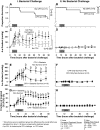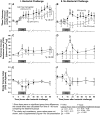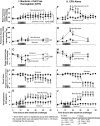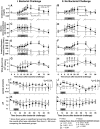Mechanistic insights into cell-free hemoglobin-induced injury during septic shock
- PMID: 33989079
- PMCID: PMC8289364
- DOI: 10.1152/ajpheart.00092.2021
Mechanistic insights into cell-free hemoglobin-induced injury during septic shock
Abstract
Cell-free hemoglobin (CFH) levels are elevated in septic shock and are higher in nonsurvivors. Whether CFH is only a marker of sepsis severity or is involved in pathogenesis is unknown. This study aimed to investigate whether CFH worsens sepsis-associated injuries and to determine potential mechanisms of harm. Fifty-one, 10-12 kg purpose-bred beagles were randomized to receive Staphylococcus aureus intrapulmonary challenges or saline followed by CFH infusions (oxyhemoglobin >80%) or placebo. Animals received antibiotics and intensive care support for 96 h. CFH significantly increased mean pulmonary arterial pressures and right ventricular afterload in both septic and nonseptic animals, effects that were significantly greater in nonsurvivors. These findings are consistent with CFH-associated nitric oxide (NO) scavenging and were associated with significantly depressed cardiac function, and worsened shock, lactate levels, metabolic acidosis, and multiorgan failure. In septic animals only, CFH administration significantly increased mean alveolar-arterial oxygenation gradients, also to a significantly greater degree in nonsurvivors. CFH-associated iron levels were significantly suppressed in infected animals, suggesting that bacterial iron uptake worsened pneumonia. Notably, cytokine levels were similar in survivors and nonsurvivors and were not predictive of outcome. In the absence and presence of infection, CFH infusions resulted in pulmonary hypertension, cardiogenic shock, and multiorgan failure, likely through NO scavenging. In the presence of infection alone, CFH infusions worsened oxygen exchange and lung injury, presumably by supplying iron that promoted bacterial growth. CFH elevation, a known consequence of clinical septic shock, adversely impacts sepsis outcomes through more than one mechanism, and is a biologically plausible, nonantibiotic, noncytokine target for therapeutic intervention.NEW & NOTEWORTHY Cell-free hemoglobin (CFH) elevations are a known consequence of clinical sepsis. Using a two-by-two factorial design and extensive physiological and biochemical evidence, we found a direct mechanism of injury related to nitric oxide scavenging leading to pulmonary hypertension increasing right heart afterload, depressed cardiac function, worsening circulatory failure, and death, as well as an indirect mechanism related to iron toxicity. These discoveries alter conventional thinking about septic shock pathogenesis and provide novel therapeutic approaches.
Keywords: cell-free hemoglobin; iron; septic shock.
Conflict of interest statement
M.T.G. and D.B.K-S. are coinventors in patents for the treatment of hemolysis (Patent No. 8980871 and 9114109). M.T.G. and J.T. are coinventors of pending patent applications and planned patents directed to the use of recombinant neuroglobin and heme-based molecules as antidotes for CO poisoning, which have recently been licensed by Globin Solutions Inc. M.T.G. and J.T. are shareholders and directors in Globin Solutions Inc. In addition, and unrelated to CO poisoning, M.T.G. and D.B.K-S. are coinventors on patents directed to the use of nitrite salts in cardiovascular diseases, which have been licensed by the United Therapeutics and Hope Pharmaceuticals, and M.T.G. is a coinvestigator in a research collaboration with Bayer Pharmaceuticals to evaluate riociguat as a treatment for patients with sudden cardiac death.
Figures






Comment in
-
Enemies at the gate: how cell-free hemoglobin and bacterial infection can cooperate to drive acute lung injury during sepsis.Am J Physiol Heart Circ Physiol. 2021 Jul 1;321(1):H131-H134. doi: 10.1152/ajpheart.00283.2021. Epub 2021 Jun 4. Am J Physiol Heart Circ Physiol. 2021. PMID: 34085840 No abstract available.
Similar articles
-
Haptoglobin improves shock, lung injury, and survival in canine pneumonia.JCI Insight. 2018 Sep 20;3(18):e123013. doi: 10.1172/jci.insight.123013. eCollection 2018 Sep 20. JCI Insight. 2018. PMID: 30232287 Free PMC article.
-
Haptoglobin therapy has differential effects depending on severity of canine septic shock and cell-free hemoglobin level.Transfusion. 2019 Dec;59(12):3628-3638. doi: 10.1111/trf.15567. Epub 2019 Oct 22. Transfusion. 2019. PMID: 31639229 Free PMC article.
-
Transfusion of older stored blood worsens outcomes in canines depending on the presence and severity of pneumonia.Transfusion. 2014 Jul;54(7):1712-24. doi: 10.1111/trf.12607. Epub 2014 Mar 3. Transfusion. 2014. PMID: 24588210 Free PMC article.
-
Effects of endothelin and nitric oxide on organ injury, mesenteric ischemia, and survival in experimental models of septic shock.Acta Pharmacol Sin. 2003 Oct;24(10):953-7. Acta Pharmacol Sin. 2003. PMID: 14531935 Review.
-
Hemodynamic and oxygen transport monitoring to titrate therapy in septic shock.New Horiz. 1993 Feb;1(1):145-59. New Horiz. 1993. PMID: 7922388 Review.
Cited by
-
Serum proteome profiling of naturally acquired Babesia rossi infection in dogs.Sci Rep. 2023 Jun 23;13(1):10249. doi: 10.1038/s41598-023-37312-9. Sci Rep. 2023. PMID: 37353646 Free PMC article.
-
Peptidomics characteristics of pediatric sepsis.Sci Rep. 2025 Mar 19;15(1):9503. doi: 10.1038/s41598-025-92101-w. Sci Rep. 2025. PMID: 40108253 Free PMC article.
-
Preclinical study for the ameliorating effect of l-ascorbic acid for the oxidative stress of chronic administration of organic nitrates on myocardial tissue in high sucrose/fat rat model.Saudi Pharm J. 2022 Oct;30(10):1405-1417. doi: 10.1016/j.jsps.2022.07.001. Epub 2022 Jul 19. Saudi Pharm J. 2022. PMID: 36387332 Free PMC article.
-
An overview of the mechanisms and potential roles of extracellular vesicles in septic shock.Front Immunol. 2024 Jan 26;14:1324253. doi: 10.3389/fimmu.2023.1324253. eCollection 2023. Front Immunol. 2024. PMID: 38343439 Free PMC article. Review.
-
Biologic Mechanisms Underlying the Heterogeneous Response to Tight Glycemic Control among Differentially Inflamed Patients in the HALF-PINT Trial.Am J Respir Crit Care Med. 2025 Aug;211(8):1463-1473. doi: 10.1164/rccm.202409-1719OC. Am J Respir Crit Care Med. 2025. PMID: 40493436 Free PMC article. Clinical Trial.
References
-
- Rhee C, Dantes R, Epstein L, Murphy DJ, Seymour CW, Iwashyna TJ, Kadri SS, Angus DC, Danner RL, Fiore AE, Jernigan JA, Martin GS, Septimus E, Warren DK, Karcz A, Chan C, Menchaca JT, Wang R, Gruber S, Klompas M; CDC Prevention Epicenter Program. Incidence and trends of sepsis in US Hospitals using clinical vs claims data, 2009-2014. JAMA 318: 1241–1249, 2017. doi:10.1001/jama.2017.13836. - DOI - PMC - PubMed
Publication types
MeSH terms
Substances
Grants and funding
LinkOut - more resources
Full Text Sources
Other Literature Sources
Medical
Miscellaneous

